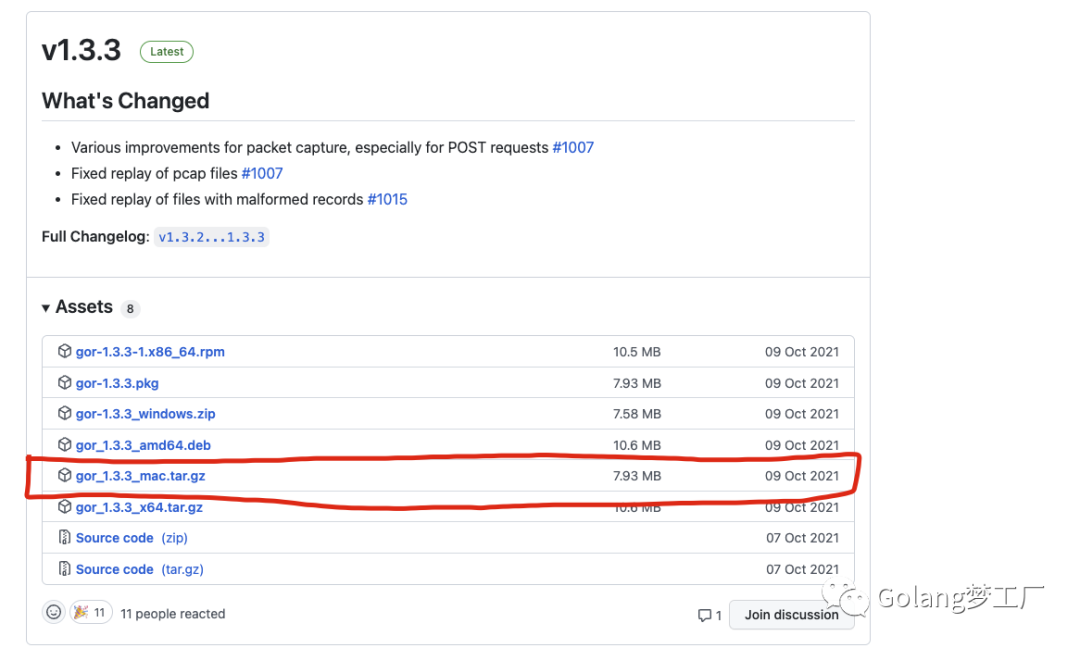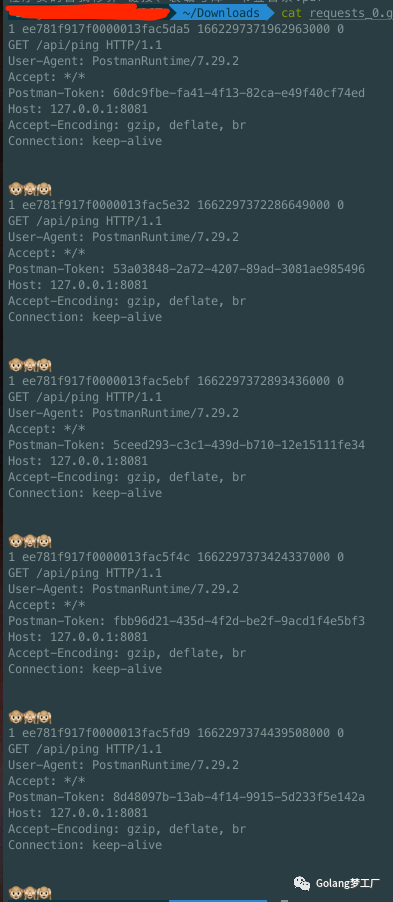前言
哈喽,大家好,我是asong。
今天给大家推荐一款使用Go语言编写的流量回放工具 -- goreplay;工作中你一定遇到过需要在服务器上抓包的场景,有了这个工具就可以助你一臂之力,goreplay的功能十分强大,支持流量的放大、缩小,并且集成了ElasticSearch,将流量存入ES进行实时分析;
废话不多,我们接下来来看一看这个工具;
goreplay介绍与安装
项目地址:https://github.com/buger/goreplay
goreplay是一个开源网络监控工具,可以实时记录TCP/HTTP流量,支持把流量记录到文件或者elasticSearch实时分析,也支持流量的放大、缩小,还支持频率限制;goreplay不是代理,无需任何代码入侵,只需要在服务相同的机器上运行goreplay守护程序,其会在后台侦听网络接口上的流量,goreplay的设计遵循 Unix 设计哲学:一切都是由管道组成的,各种输入将数据复用为输出;可以看一下官网画的架构图:

goreplay的安装也比较简单,只需要在https://github.com/buger/goreplay/releases 下载对应操作系统的二进制文件即可,我的电脑是mac的:

解压缩后就是一个二进制文件gor,将其添加到您的环境变量中,方便我们后续的操作;
使用示例
实时流量转发
首先我们要准备一个Web服务,最简单的就是用Gin 快速实现一个helloworld,替大家实现好了:https://github.com/asong2020/Golang_Dream/tree/master/code_demo/gin_demo;
import (
"flag"
"github.com/gin-gonic/gin"
)
var Port string
func init() {
flag.StringVar(&Port, "port", "8081", "Input Your Port")
}
func main() {
flag.Parse()
r := gin.Default()
r.Use()
r1 := r.Group("/api")
{
r1.GET("/ping", func(c *gin.Context) {
c.JSON(200, gin.H{
"message": "pong",
})
})
}
r.Run("localhost:" + Port)
}
因为资源有限,这里我用一台电脑起两个进程来模拟流量转发,分别启动两个web服务分别监控端口号8081、8082:
$ go run . --port="8081" $ go run . --port="8082"

服务弄好了,现在我们来开启gor守护进程进行流量监听与转发,将8081端口的流量转发到8082端口上:
$ sudo gor --input-raw :8081 --output-http="http://127.0.0.1:8082"

现在我们请求8081端口:
$ curl --location --request GET 'http://127.0.0.1:8081/api/ping'
可以看到8082端口同样被请求了:

流量放大、缩小
goreplay支持将捕获的流量存储到文件中,实际工作中我们可以使用捕获的流量做压力测试,首先我们需要将捕获的流量保存到本地文件,然后利用该文件进行流量回放;
还是上面的Web程序,我们将端口8081的流量保存到本地文件:
$ sudo gor --input-raw :8081 --output-file ./requests.gor
我们对8081端口执行了5次请求:

然后我们对8082端口进行流量缩小测试,缩小一倍:
gor --input-file "requests_0.gor" --output-http="http://127.0.0.1:8082|50%"
调整百分比就是进行流量放大、缩小,这里我们缩小了一倍,可以看到只有2次请求到了8082端口;我们可以调整流量回放的速度,比如我们调整流量以10倍速度进行重播:
$ gor --input-file "requests_0.gor|1000%" --output-http="http://127.0.0.1:8082|50%" # 1000%就是放大10倍
流量写入到ElastichSearch
goreplay可以将捕获的流量导出到Es中,只需要执行如下命令:
$ gor --input-raw :8000 --output-http http://staging.cm --output-http-elasticsearch localhost:9200/gor
我们不需要提前创建索引结构,他将自动创建,具体结构如下:
type ESRequestResponse struct {
ReqURL string `json:"Req_URL"`
ReqMethod string `json:"Req_Method"`
ReqUserAgent string `json:"Req_User-Agent"`
ReqAcceptLanguage string `json:"Req_Accept-Language,omitempty"`
ReqAccept string `json:"Req_Accept,omitempty"`
ReqAcceptEncoding string `json:"Req_Accept-Encoding,omitempty"`
ReqIfModifiedSince string `json:"Req_If-Modified-Since,omitempty"`
ReqConnection string `json:"Req_Connection,omitempty"`
ReqCookies string `json:"Req_Cookies,omitempty"`
RespStatus string `json:"Resp_Status"`
RespStatusCode string `json:"Resp_Status-Code"`
RespProto string `json:"Resp_Proto,omitempty"`
RespContentLength string `json:"Resp_Content-Length,omitempty"`
RespContentType string `json:"Resp_Content-Type,omitempty"`
RespTransferEncoding string `json:"Resp_Transfer-Encoding,omitempty"`
RespContentEncoding string `json:"Resp_Content-Encoding,omitempty"`
RespExpires string `json:"Resp_Expires,omitempty"`
RespCacheControl string `json:"Resp_Cache-Control,omitempty"`
RespVary string `json:"Resp_Vary,omitempty"`
RespSetCookie string `json:"Resp_Set-Cookie,omitempty"`
Rtt int64 `json:"RTT"`
Timestamp time.Time
}
goreplay提供了太多的功能,就不一一介绍了,可以通过执行help命令查看其他高级用法,每个命令都提供了例子,入手很快;
$ gor -h Gor is a simple http traffic replication tool written in Go. Its main goal is to replay traffic from production servers to staging and dev environments. Project page: https://github.com/buger/gor Author: <Leonid Bugaev> leonsbox@gmail.com Current Version: v1.3.0 -copy-buffer-size value Set the buffer size for an individual request (default 5MB) -cpuprofile string write cpu profile to file -exit-after duration exit after specified duration -http-allow-header value A regexp to match a specific header against. Requests with non-matching headers will be dropped: gor --input-raw :8080 --output-http staging.com --http-allow-header api-version:^v1 -http-allow-method value Whitelist of HTTP methods to replay. Anything else will be dropped: gor --input-raw :8080 --output-http staging.com --http-allow-method GET --http-allow-method OPTIONS -http-allow-url value A regexp to match requests against. Filter get matched against full url with domain. Anything else will be dropped: gor --input-raw :8080 --output-http staging.com --http-allow-url ^www. -http-basic-auth-filter value A regexp to match the decoded basic auth string against. Requests with non-matching headers will be dropped: gor --input-raw :8080 --output-http staging.com --http-basic-auth-filter "^customer[0-9].*" -http-disallow-header value A regexp to match a specific header against. Requests with matching headers will be dropped: gor --input-raw :8080 --output-http staging.com --http-disallow-header "User-Agent: Replayed by Gor" ..........省略
goreplay基本实现原理
goreplay底层也是调用Libpcap,Libpcap即数据包捕获函数库,tcpdump也是基于这个库实现的,Libpcap是C语言写的,Go语言不能直接调用C语言,需要使用CGo,所以goreplay可以直接使用谷歌的包github.com/google/gopacket,提供了更方便的操作接口,基于goreplay封装了input、output,在启动的时候通过命令行参数解析指定的input、output,input读取数据写入到output中,默认是一个input复制多份,写多个output,多个input之前是并行的,但是单个intput到多个output是串行的,所以input-file会有性能瓶颈,压测的时候需要开多个进程同时跑来达到压测需求;
goreplay的源码有点多,就不在这里分析了,大家感兴趣哪一部分可以从gor.go的main函数入手,看自己感兴趣的部分就可以了;
总结
goreplay提供的玩法非常丰富,合理的改造可以做成回归工具帮助我们确保服务的稳定性,别放过这个自我展现的机会~。
以上就是利用Go语言实现流量回放工具的示例代码的详细内容,更多关于Go语言流量回放工具的资料请关注好代码网其它相关文章!
